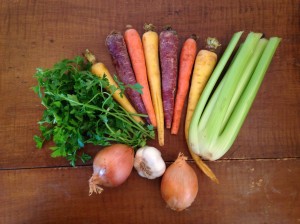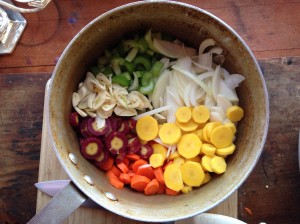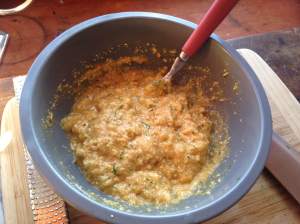Tags
comfort, Jewish, knaidel, matzah ball, simple, vegetarian, winter
This past week in New York, winter really dug her talons under our skin. I responded the only way I know how: with long underwear, double socks, and a balaclava plus fleece-lined Andean hat. By Friday afternoon, fearing flash hypothermia, I ran all the way home from the subway.
Cold weather this extreme required serious and decisive action.
I needed a food that carried some heft; ideally, a history of persecution. Unfortunately (and I realize these may inflame some), the vast majority of Ashkenazi food is Ashke-nasty. I suspect that, along with the promise of better economic opportunities and religious freedom, my grandparents immigrated to America in search of tastier cuisine. But matzah ball soup –“the gateway drug to Jewish food”–shines as a glorious exception, warming and comforting like Bubbe’s hugs.
My mother would make a pot of the stuff every Friday night between October and May. She used the packaged mix and bouillon, dressing it up with a quick vegetable broth of sliced onions, carrots, celery, and garlic. Much later, I learned that most Jewish grandmas add tons of chicken in the form of stock and schmaltz. But our version was always vegetarian, and that’s still what I usually make. If you want that chicken-y flavor, by all means lay on the schmaltz.
For the mirepoix-ish broth, gather some vegetables. (I used seven of these pretty rainbow carrots, seven ribs of celery, two small onions, and six cloves of garlic.) Wash, peel, and slice. Keep the scraps in a container in your freezer until you make stock, or until you move out. (Note: if you decide to move to a new apartment before you use the scraps to make stock, do NOT pack and bring them with you. Just throw them away and start a new scrap container. Repeat cycle until priced out of Brooklyn.)
Throw all your vegetables into the biggest pot you have. My biggest pot happened to have been occupied with the last couple of quarts of homemade yogurt. So many blessings! Dump that junk into something else and make room for your vegetables and a little bit of oil. Heat and stir everything in the pot for a few minutes until the garlic and onions are just fragrant, then cover generously with water or stock and bring to a boil.
Let’s talk balls. Meir is already giggling, so we’ll replace that word with the one our ancestors and a recent spelling bee champ used: knaidel. Knaidelach (the plural of knaidel) share a category with soufflés and Thanksgiving turkeys — foods that reveal themselves as successes or failures in a highly anticipated “moment of truth.” Growing up, I would perform the weekly ritual of checking the knaidel in my bowl: was it floating or sinking, plump, fluffy and tender, or, heaven forbid, dense and rubbery inside? This last would be a grave shonda.
For basic knaidelach, crib the recipe off the Manischewitz matzah meal carton. (I threw in a little finely minced garlic and dill for flava.) Don’t overwork the batter; the trick to avoiding the dreaded cannon ball knaidel is all in a light touch. Mix the ingredients until they are just barely combined, then let everything chill in the fridge for at least 20 minutes. By this time, your soup should be coming to a boil and you’re ready to shape the balls. My grandmother would scoop and drop the knaidelach into the soup without futzing too much, resulting in a very fluffy (albeit irregular) knaidel. As with most all Jewish topics, opinions on proper knaidel techniques vary. The omission of chicken schmaltz alone should provoke a lengthy Talmudic discussion, but I’m a firm believer in reinventing tradition (especially if you’re a vegetarian).
Once all the vegetables and knaidelach are in the pot, cover and heat on a low boil until the vegetables are tender and the knaidelach are cooked through, 30-40 minutes.
Finish with salt and white pepper to taste, and a handful of freshly chopped parsley.
This soup is approved by the FDA to treat and cure all winter maladies, physical and emotional.
While cooking, I listened to: Chilly Icelandic sounds courtesy of KEXP Seattle’s Live Performances Podcast (Árstíðir‘s singy, stringy indie-folk and ADHD, an Everything Bagel of progressive jazz, blissful grooves, and out-there jams), followed up with a wee nip of Sleater-Kinney.






This reminds us of the wonderful Friday night chicken soup and knaidelach of years past. This blog makes our mouths water (and our hearts kvell!)
LikeLike
Pingback: Not your mom’s chicken noodle. Unless your mom is Sichuanese. | soup d'état